Are cleaning and disinfectant products corrosive?
Infrastructure such as footbaths and wash-down facilities are important components of effective on-farm biosecurity. Demonstration trials have been conducted to investigate the potential corrosive ability of various cleaning and disinfectant products on different metal surfaces.
Two demonstration trials were conducted and the same treatments were used in both. Products included a detergent made to a 10% solution (Farmcleanse), three products containing 120g/L didecyl dimethyl ammonium chloride (DDAC) made to a 1% solution (Sporekill®, Steri-max® and Path-X™), and water as a control. Both trials demonstrated the effects of the above products on five different metals; unpainted steel, painted steel, galvanised, aluminium and stainless steel (grade 304).
The first experiment consisted of the metals being completely submerged in solution for 8 weeks, whilst in the second experiment the metals were treated by being dipped in the solutions frequently (2-3 times a week) then exposed to field conditions (temperature and humidity) for a total of 12 weeks.
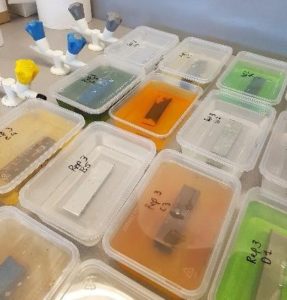
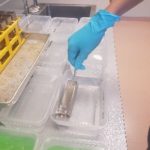
Outcomes of this research
The demonstration trials showed that the detergent and disinfectant products caused low levels of surface rust development over the 8-12 week period for the majority of metals. Unpainted steel was the most susceptible to surface rust development, while galvanised steel, aluminium and stainless steel were the least susceptible.
When submerged in solution, the detergent and disinfectant products did not corrode the metals significantly more than water alone. The water treatment also appeared to have similar corrosive abilities as the other products trialled in this experiment.
When dipped frequently and exposed to field conditions, all three disinfectant products appeared to be more corrosive on unpainted steel compared to the water and detergent treatments. Furthermore, the DDAC products had shown to be more corrosive on unpainted steel when dipped frequently as opposed to the submerged in solution application method.
Remember...
Remember to always follow label directions for cleaning and disinfectant products. After the appropriate exposure time you can rinse metal surfaces with clean water to minimise the risk of rusting.
What did the corrosion demonstration trial show?
Unpainted steel
Submerged in solution
- Water appeared to have similar corrosive abilities as the disinfectant and QA products.
Dipped frequently
- The QA products appeared to be more corrosive than the detergent and water treatments with frequent dipping application.
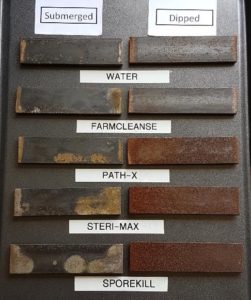
Painted steel
Submerged in solution
- The paint bubbled and peeled across most treatments, with water only having the least amount of damage to the paint.
- Rust development was present on the cut edges for all treatments.
Dipped frequently
- The paint remained in good condition for all treatments.
- Minor rust development was present where there were chips in the paint.
- Rust development was present on the cut edges for all treatments.
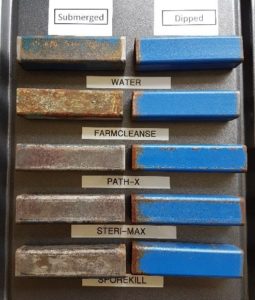
Stainless steel (grade 304)
Submerged in solution
- The stainless steel remained in good condition for the duration of the experiment against all treatments.
- Rust development was present on the cut edges of most treatments with the detergent having the least amount of rust visible.
Dipped frequently
- None of the treatments appeared to degrade the stainless steel for the duration of the experiment.
- Rust was present on the cut edges of the stainless steel on most treatments but with the detergent treatment having the least amount of rust development.
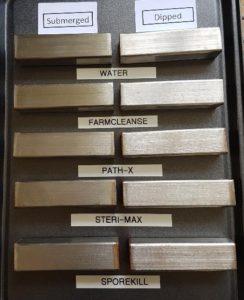
Aluminium
Submerged in solution
- All treatments oxidised the aluminium with the exception of Steri-max®.
- The oxidised aluminium plates changed colour and developed a chalky texture across the surface.
Dipped frequently
- The aluminium remained in good condition for the duration of the experiment across all treatments.
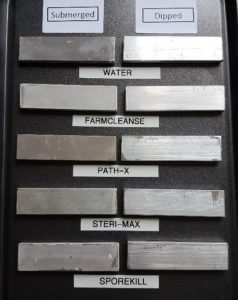
Galvanised steel
Submerged in solution
- A white precipitate developed on the surface of the galvanised steel plates on most treatments, except the detergent.
- Rust developed on the cut edges of the galvanised steel plates treated with water.
Dipped frequently
- The galvanised steel remained in good condition for the duration of the experiment and across all treatments.
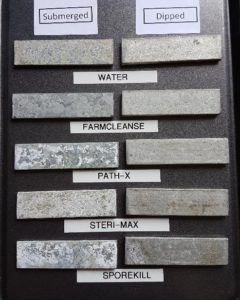
For more information about this work contact the better bananas team – betterbananas@daf.qld.gov.au or 13 25 23
This trial was funded as part of project BA14013 Fusarium wilt Tropical Race 4 – Biosecurity and sustainable practices was funded by Hort Innovation, using the Banana research and development levy, co-investment from the Queensland Department of Agriculture and Fisheries and contributions from the Australian Government. Hort Innovation is the grower-owned not-for-profit research and development corporation for Australian Horticulture.


